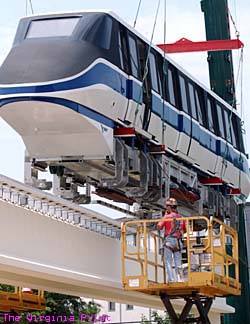Superfluids
Superconductors
Ever since the discovery of superconductors, there has been great interest in their use in electronics. It turns out that the magnetic properties of superconductors has been more useful in a larger variety of applications than the lack of resistance.
 |
Maglev trains use superconductors to levitate the train above magnetic rails. This enables them to operate without friction, and therefore acheive unheard of speeds. The maglev train below is being installed at the Old Dominion University in Hampton, Virginia. It is the first to be installed in the US. Unfortunately, due to the short track it is on, it can only reach speeds of 40 miles per hour. Maglevs, with sufficient track, can reach speeds over 300 mph. A new Maglev train in Shanghai recently broke the 500 Km/h barrier (310 mph). These trains are also more efficient because there less energy loss to friction between the train and the track. |
 |
MRI (Magnetic Resonance Imaging) machines use superconductors to deliver a strong enough magnetic field so that hydrogen atoms in the body's fat and water molecules will pick up energy from the field which can then be detected by special instruments. SQUIDS (Superconducting QUantum Interference Device) can be used like an MRI, but without the need for a strong magnetic field. They can detect magnetic fields of infinitely small magnatudes. They can also be used for extremely precise motion detection. |
Superconductor's magnetic properties have also been used in particle accelerators such as the new Large Hadron Collider at CERN. Superconducors used instead of normal wire in electric generators increase efficiency, and superconductors can be used to stabilize power grids. Superconducting wire can also be used to save space in wiring for large cities. Two hundred and fifty pounds of liquid-nitrogen cooled superconducting wire is enough to replace nine tons of conventional copper wire. As new properties of superconductors are being discovered, and superconducting temperature limits are being exceeded with new compounds, new uses for superconductors are bound to be implemented in today's high-tech world.